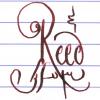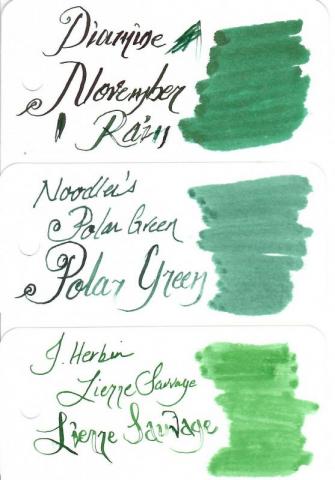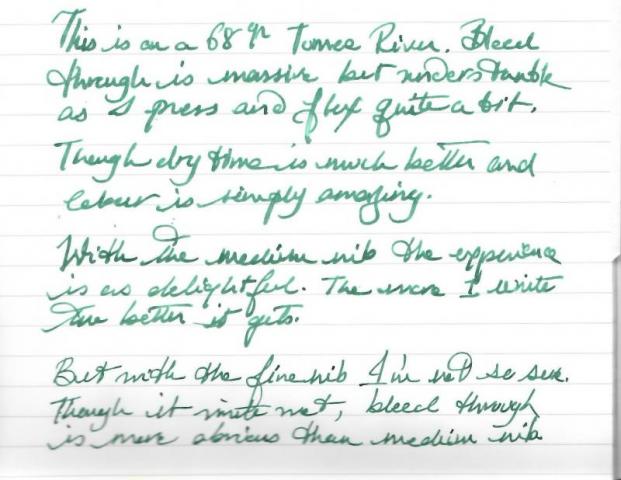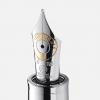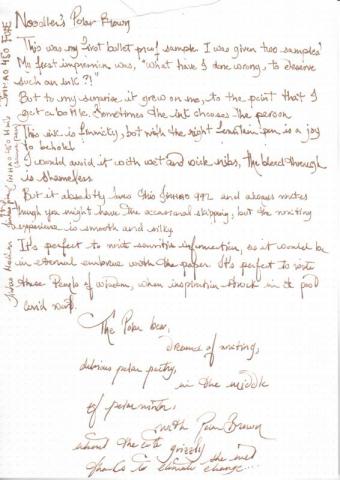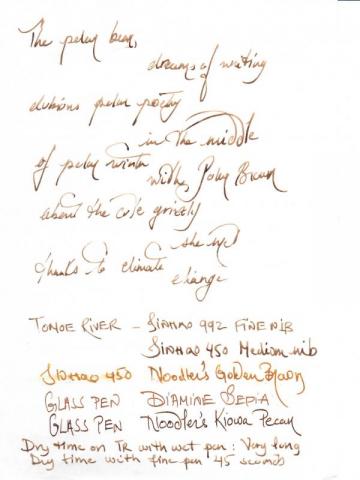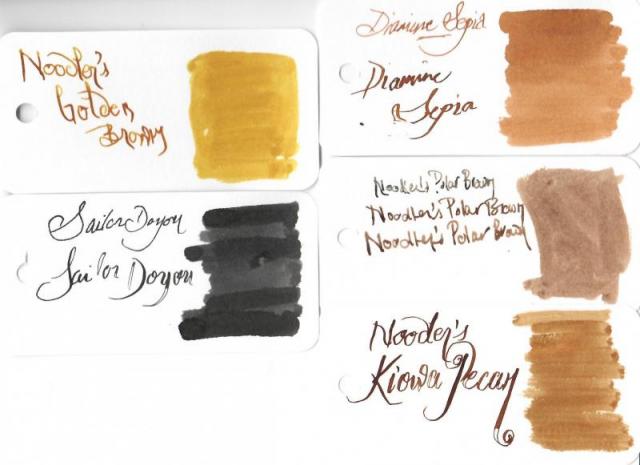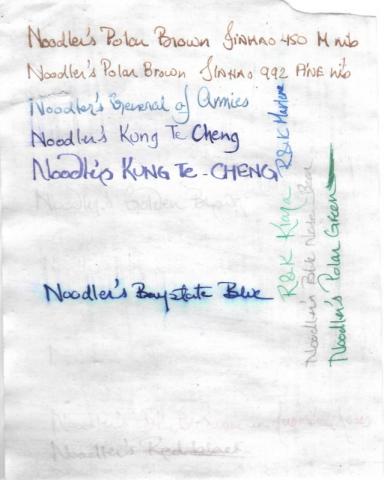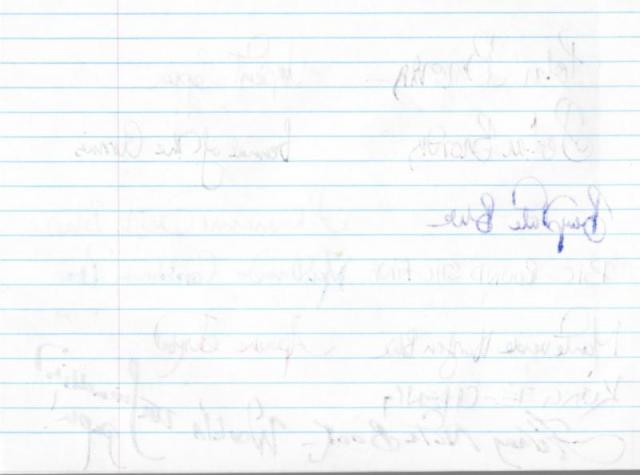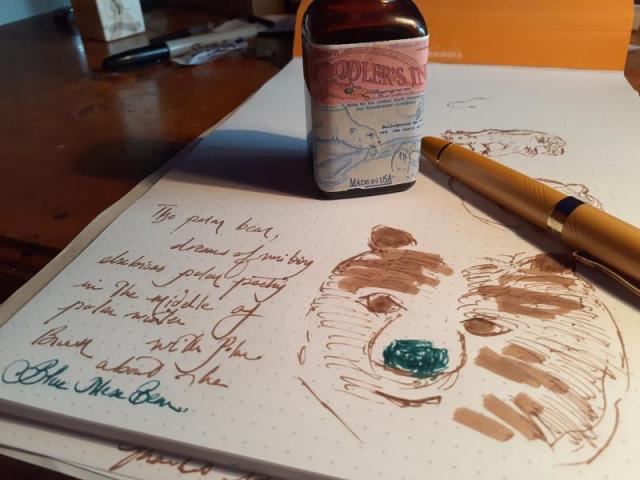Search the Community
Showing results for tags 'polar'.
-
This is a muted , bullet proof purple in the Polar series. Polar series consists of five inks. Black, Brown, Green, Blue and Purple. Comparison: Polar inks were developed for cold regions. In their original iteration they didn’t freeze, but had flow issues, I believe. In this updated version they turn into slush in subzero temperatures. TR 68 gr /Reverse fude #6 While I live in a relatively cold area, I have not found the need to ever use a fountain pen or pen for that matter outdoors. Frankly, I doubt if I can hold a pen in -30°C /-22°F with a gigantic mitt. And frankly I don't see the point of getting frostbite to prove a point. Midori / dry time decreases drastically on this paper, 9 seconds. Nib is medium Polar Blue and Purple are similar in behaviour: they are both very wet, and muted. So, your EF will probably turn in a fine. These i cellulose reactive inks, don’t behave well on cheap/ thin paper, that is they bleed through like there’s no tomorrow. HP 32 Polar Purple doesn’t shade, unless you use a wide nib. It’s a pastel/muted/flat colour. I like pastel. It's not distracting Shading on TR 68 gr/ #6 fude nib - There is shading on this paper. But dry times are above 20s on this paper. Dry time on Rhodia is almost immediate, with Midori is about 10 seconds. Fude nib/ Midori Polar inks have a bad rap in general. They can have some flow issues at time and need the right pen/nib combination. They stain (Green and Brown do) but a bit of Doyou/Red Rattlers and the stain disappears. Thought they are best to be married to one pen and they live happily ever after. I have Green in a Kaweco and brown in Chinese pen. They just do fine. Clairefontaine/ fude Rhodia - Water test. Note the water test was done immediately after writing. · Pens used: Jinaho 450 fude/ medium nib - Reverse · Papers used: TR 68 gr / Midori/ Rhodia/ Clairefontaine /HP32 · Shading: None. Pastel · Ghosting: On thin absorbent paper yes. With pens · Bleed through: on thin papers for sure. · Flow Rate: Wet. · Lubrication: Good · Nib Dry-out: Needs a well-sealed pen. · Start-up: No · Saturation: Muted · Shading Potential: None · Sheen: None · Spread / Feathering / Woolly Line: Not noticed. But I’m sure with thin absorbent paper it would feather and fly! · Nib Creep / “Crud”: Not noticed. · Staining (pen): I don’t know. · Clogging: None · Water resistance: Excellent · Availability: 90 ml bottles There is a strong possibility that this ink might stain plastic convertors.
- 13 replies
-
Noodler’s Polar Green This is my 2nd Polar ink. I have the Polar Brown already and I’ve just filled a pen with Polar Blue. The inks are not at all similar. Polar Blue is the wettest. I’ve read that the Polar series could be mixed to create a variety of colours, which is fun. Green is not my favorite color, especially dark green. However, when I saw swabs of this ink, I knew I would get it. I got a sample just in case and the moment I filled a pen I knew it was my type of ink. Who is this ink for: For those who like bulletproof inks and can accommodate the ink’s idiosyncrasies and appreciate woolly lines (I do), and live in North America. I honestly don’t think it’s worth the shipping cost for overseas. I’m sure there are other alternatives available. Note the woolly line effect happens with a wet, flexed Kanwrite. When wet, the ink is Emerald Green, then dries to dark green, think boreal forest to sage, depending paper. This ink is paper/pen specific. Personally, I really like it with a Kanwrite ultra flex on Midori. I find the combination gives a vintage look. It’s a sage color on Tomoe River but one would need a blotter/copy paper underneath the page as the ink would bleed through several pages. It’s a bulletproof ink, with all it entails. The flow is not as wet 54 Massachusetts or Polar Blue…., I would say viscous, it reminds me of Kung Te-Cheng in this regard. People often say that it feathers badly. I’ve been writing pages with it, with different nibs and to be honest, I like the effect. See for yourself....I would not use it on copy paper... • Pens used: Kanwrite ultra flex – Jinhao 450 – Pilot Metro Fine – Nameless Kaweco type EF fountain pen… Note for testing the ink I filled the Pilot Metropolitan with the ink and left it for a couple of weeks to check if it would dry up. It didn’t. Longer periods might need some coaxing. Note the Pilot Fine nib seems finer than the Chinese • Shading: A bit only with flex nib on TR • Ghosting: Depending nib/ flow combination • Dry time: 2 seconds on Rhodia....Longest on TR • Bleed through: As above. • Flow Rate: Decent. It was least agreeable with a Chinese Kaweco style with an Ef nib….though after a second filling it wrote noticeably better. I won’t recommend it for dry writers…but flow is not wet, nor dry, I would say in between. I would say, when you start writing it might be a shy, but then it flows. • Lubrication: Average. • Nib Dry-out: It can happen…. • Start-up: Almost immediate. I noticed some skipping with EF nib. • Saturation: saturated • Shading Potential: Vaguely on TR • Sheen: Nope…t • Show-Through: With flex nib and fine wet nibs. • Spread / Feathering / Woolly Line: On Midori with flex…gives a vintage look…I like it. • Nib Creep / “Crud”: Yes on all nibs… you’ll have a green patina on all your nibs. • Staining (pen): Don’t know yet • Staining (hands): Easy to wash. • Clogging: Nope • Water resistance: Bullet proof. • Availability: Only in bottle. Note on some scans I've written the type of paper with a greenish ink. It's General of the Armies.... I didn't add a swab as would time, it would revert to blue Swab comparison On Amazon copy paper Mnemosyne Midori Tomoe River Tomoe River 68 gr Full page Rhodia Rhodia Please feel free adding your scans, impression.... The more the merrier.....
- 16 replies
-
Hi all! I did a little essay on the chemistry of fountain pen inks for extra credit in my AP Chemistry class. I thought you might enjoy reading it as well. Please feel free to let me know if anything is wrong (I don't think there's anything wrong but I know there's chemists lurking on this forum) and enjoy! The Chemistry of Fountain Pen Inks Even in today’s increasingly digital society, writing and print publications remain ubiquitous parts of our daily lives. From completing chemistry homework to reading the newspaper, we are constantly in contact with words on paper. Although the structure of the paper is mostly consistent, even with seemingly different types, the inks used vary greatly and are impressive examples of chemical engineering applied to an important part of daily life. Inks are used for countless applications, but the two most common uses are printing and writing. Printing inks, which create the vibrant pages of textbooks, newspapers, and magazines, however, represent only one part of the ink family. The other, more chemically diverse branch of this family, is writing ink. The chemical makeup of inks has incredible variation between the types of pens the inks are designed for, and even within different inks for the same type of pen. The most strikingly variant and chemically interesting group of writing inks are those designed for use in fountain pens. Due to the feed system used in fountain pens to bring ink to the tip, or nib, of the pen, fountain pen inks must be solutions rather than pigment based like many of their ballpoint peers. The inks for fountain pen use must also be water soluble, not tinctures. This requirement stems from the nature of the material that the pen bodies are made from. Many pens, especially those from the early 20th century, are made from celluloid, ebonites, or other natural plastics, which are soluble in alcohol. Any tincture inks would damage these pens. Because of the unique requirements created by a fountain pen’s feed system and the materials used to make vintage pens, many fountain pen inks are made of several fundamentally similar ingredients. First and foremost, all are made mostly of water, the solvent of the ink. A solute that occurs in nearly all fountain pen inks is a water soluble aniline dye composed of a Nitrite group bound to a phenyl group, forming a basic amine, phenylamine. Although many of these dyes are actually more soluble as tinctures, they are dissolved in water to protect the pen materials, as discussed earlier. Other common solutes are surfactants to increase ink flow, biocide compounds to prevent fungal growth in ink, and glycerin to increase ink viscosity. Despite fundamental similarities and rigid requirements to protect pens, fountain pen inks manage to present a wide range of properties to the consumer. These features include greatly decreased freezing points, total permanence on paper, scents, color changes, and decreased drying times. Inks with lowered freezing points are formed by the addition of solutes that dissolve into multiple ions or ring-based covalent hydrocarbons (in the case of polar covalent solutes). Paper permanence is achieved through the addition of solutes that bond with the cellulose of the paper, ensuring that the ink remains permanently marked on the paper and fraud-proof. Scents are the easiest of the properties to create, made by adding ester based solutes formed by the reaction of carboxylic acid and alcohols to the ink solution. Color changing inks are formed by making an ink with multiple dyes, only one of which forms the type of permanent cellulose bond described earlier. When the ink is rinsed with water, all of the dyes except that which bonds with the cellulose wash away, “changing” the color of the ink on the page. Decreased drying times are created, counterintuitively, by adding higher surfactant levels than usual and increasing flow. This allows the ink to seep into the fibers of the paper faster, and stay wet and smudge-prone for a shorter period of time. Inks remain one of the most important parts of everyday life, and will for the foreseeable future. The chemical diversity is striking across different types of inks, for different applications. For fountain pen inks however, more unites the inks than differentiates them. Yet even with this surface level chemical uniformity, the addition of trace levels of different solutes allows fountain pen inks to come in a vast rainbow of colors and an array of special properties.
-
Polar Brown is one of my favorite inks. Ironically, I’m not a fan of the color. It’s somehow bland. It can be a frustrating and finnicky ink, depending the pen used. But in this day age, where the veil on life’s non-permanence and uncertainty has been torn to bits, an ink, as permanent as the paper it bonds with is a source of comfort. When I first got into inks, being too lazy, I ordered a bunch of mystery samples. There were two Polar Browns. When I inked my pen, I told myself, what have I done to deserve such an ink in double amounts. But it grew on me, to the point that I bought a bottle, and I always have a couple of pens inked up, just in case, I have to jot down some important information, words of wisdom, sign a check or write a shopping list. Not a pleasant feeling when your painstakingly craft list melts after an impromptu drizzle or stray snowflake…… It dries in less than 10 seconds with a wet medium nib, and 3 with a fine on Rhodia dotpad. On copy paper it’s instantaneous. However, it takes forever to dry on Tomoe River with a wet nib, but it shades. With a fine nib, 45 seconds, until smudge free… It is also one of the easiest inks to clean out of a fountain pen. I’ve tried it even in a vintage Waterman and cleaning was a breeze. Personally, this is one of those rare inks that I would not use with a stub/ oblique nib/ fude. With a wet/ wide combo it would ghost and bleed through unabashedly. Though sometimes I prefer that dark rich brown, haunting the paper, than the mild muted brown it usually is. I’m not sure if it would be happy in a dry pen. I have had it in a Jinhao 992 for a year with no problem. In a Jinhao 450 with a fude nib, it had flow issues but when I changed the nib to a medium it was much better. When it flows, it’s a joy to write with. And unsurprisingly Polar Brown, loves Noodler’s nib creeper. On Rhodia dot pad Rhodia Back On Tomoe River Swab comparaison On Amazon Copy paper - Front Back On Hilroy - King of the fountain pen unfriendly notebooks Back Yesterday it was raining. So, I decided to do a permanence test.... Note the Black Swan in English Roses was actually Sailor Yodaki... Before After 2 hours under rain/sleet/snow After 18 hours under constant rain Finally I subjected the visible texts to swabs of alcohol on the left side and bleach to ride side....
-
I'm just getting started in homemade inks. I live up in the North, where liquid water is regarded as unnatural. Ok, it's not that bad, but we do have cold winters, especially in hiking areas. Noodler has a line of inks called "Polar". The first generation of Noodler's Polar was resistant to much lower temperatures, but the later versions only work down to -15 - -20°c. Right now it's -25°c here, and -35°c is common. I would very much like to write in my journal while hiking, so I want to make a freeze resistant ink that can handle the coldest winters, let's say -45°c. When it comes to freeze resistant inks, what carrier liquids do they typically use? I usually use a pigment ink, but sometimes use KWZ Iron Gall ink. Pigment and iron gall have different requirements on their carrier fluids. Which freeze resistant carriers could I use for iron gall and pigment inks respectively?
- 3 replies
-
- freeze resistant
- cold
-
(and 2 more)
Tagged with:
-
Hi! I just got from an ebay seller a bottle of Noodler's Polar Black. The label also carries "Edition 2006". What does it mean? Was it produced in 2006 or is it just the formulation that was invented back there? If it was bottled 9 years ago, shall I hope that the ink still retain its properties (i.e. bulletproof, anti-icing, etc.)? Thanks for any information!
- 1 reply
-
- noodlers
- polar black
-
(and 2 more)
Tagged with:

